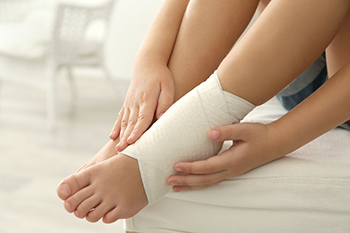Items filtered by date: September 2024
Custom Orthotics For Foot and Heel Pain

Step into relief and reclaim your mobility! Foot and heel pain can be a thing of the past with the right Custom Orthotics. Customized to your unique foot structure, they provide the support and alignment needed to alleviate discomfort. Whether you're walking, running, or simply standing, Custom Orthotics ensure every step is cushioned and pain-free. Don't let foot ailments dictate your day. With Custom Orthotics, embrace a world of comfort and freedom. Call today to schedule an appointment.
What Is a High Ankle Sprain?

A high ankle sprain is an injury to the syndesmotic ligament complex that stabilizes the tibia, or shin bone, and fibula. This type of sprain occurs when the ankle is forcefully twisted outward or when the leg rotates inward while the foot is fixed. Unlike common ankle sprains, high ankle sprains often heal more slowly due to the involvement of these critical ligaments. Early symptoms include pain above the ankle, swelling, and difficulty bearing weight. Risks for high ankle sprains include sports activities, especially those involving sudden changes in direction or impact. Complications from untreated high ankle sprains can lead to chronic instability and susceptibility to future injuries. Diagnosis typically involves a physical examination and imaging tests like X-rays or MRI scans to assess the severity of the injury. Treatment varies depending on the injury's extent. If you are experiencing ankle pain, it is suggested you schedule an appointment with a podiatrist for proper diagnosis and care.
Ankle sprains are common but need immediate attention. If you need your feet checked, contact Joseph M. LaCava, DPM from Arkansas. Our doctor can provide the care you need to keep you pain-free and on your feet.
How Does an Ankle Sprain Occur?
Ankle sprains take place when the ligaments in your ankle are torn or stretched beyond their limits. There are multiple ways that the ankle can become injured, including twisting or rolling over onto your ankle, putting undue stress on it, or causing trauma to the ankle itself.
What Are the Symptoms?
- Mild to moderate bruising
- Limited mobility
- Swelling
- Discoloration of the skin (depending on severity)
Preventing a Sprain
- Wearing appropriate shoes for the occasion
- Stretching before exercises and sports
- Knowing your limits
Treatment of a Sprain
Treatment of a sprain depends on the severity. Many times, people are told to rest and remain off their feet completely, while others are given an air cast. If the sprain is very severe, surgery may be required.
If you have suffered an ankle sprain previously, you may want to consider additional support such as a brace and regular exercises to strengthen the ankle.
If you have any questions please feel free to contact our office located in Hot Springs, AR . We offer the newest diagnostic and treatment technologies for all your foot and ankle needs.
We Can Treat Your Foot or Ankle Pain
Tips to Prevent Ankle Injuries in Volleyball

Volleyball players are prone to ankle injuries due to the dynamic nature of the game. To reduce the risk, proper warm-up routines are essential, focusing on flexibility and strength exercises specifically for the lower legs. Wearing supportive footwear designed for volleyball can also help to stabilize the ankle and absorb shock. Additionally, practicing correct techniques for jumping and landing minimizes strain on the ankles. It is also important to strengthen the muscles surrounding the ankle through targeted strength training exercises. Incorporating balance and agility drills into regular training can improve coordination and reduce the likelihood of injury. Ankle injuries are typically painful, and can force a volleyball player to refrain from playing. If you have sustained an ankle injury while playing volleyball, it is suggested that you promptly visit a podiatrist who can offer effective treatment solutions.
Sports related foot and ankle injuries require proper treatment before players can go back to their regular routines. For more information, contact Joseph M. LaCava, DPM of Arkansas. Our doctor can provide the care you need to keep you pain-free and on your feet.
Sports Related Foot and Ankle Injuries
Foot and ankle injuries are a common occurrence when it comes to athletes of any sport. While many athletes dismiss the initial aches and pains, the truth is that ignoring potential foot and ankle injuries can lead to serious problems. As athletes continue to place pressure and strain the area further, a mild injury can turn into something as serious as a rupture and may lead to a permanent disability. There are many factors that contribute to sports related foot and ankle injuries, which include failure to warm up properly, not providing support or wearing bad footwear. Common injuries and conditions athletes face, including:
- Plantar Fasciitis
- Plantar Fasciosis
- Achilles Tendinitis
- Achilles Tendon Rupture
- Ankle Sprains
Sports related injuries are commonly treated using the RICE method. This includes rest, applying ice to the injured area, compression and elevating the ankle. More serious sprains and injuries may require surgery, which could include arthroscopic and reconstructive surgery. Rehabilitation and therapy may also be required in order to get any recovering athlete to become fully functional again. Any unusual aches and pains an athlete sustains must be evaluated by a licensed, reputable medical professional.
If you have any questions please feel free to contact our office located in Hot Springs, AR . We offer the newest diagnostic and treatment technologies for all your foot and ankle needs.

